 To enhance service speed and avoid tariff delays, we've opened a US warehouse. All US orders ship directly from our US facility.
To enhance service speed and avoid tariff delays, we've opened a US warehouse. All US orders ship directly from our US facility.
| Cat. No. | Product Name | Field of Application | Chemical Structure |
|---|---|---|---|
| DC72027 | Purinostat mesylate |
Purinostat mesylate is a selective inhibitor of HDAC. Purinostat mesylate inhibits class I and class IIb HDACs with IC50s from 0.81 to 11.5 nM. Purinostat mesylate induces apoptosis and affects cell cycle of LAMA84 and 188 BL-2 cells, and shows potently anti-leukemia effects in vivo. Purinostat mesylate can be used for the research of lymphoblastic leukemia.
More description
|

|
| DC71743 | TH-6 |
TH-6 is a potent HDAC inhibitor with IC50s of 0.115, 0.135, 0.242, 0.138, 2.120 µM for HDAC1, HDAC2, HDAC3, HDAC6, HDAC8, respectively. TH-6 inhibits cell migration and invasion. TH-6 induces apoptosis and cell cycle arrest at G2/M phase. TH-6 shows anti-tumor activity.
More description
|

|
| DC71314 | HC-Toxin |
HC-Toxin, a cyclic tetrapeptide, is a potent HDAC inhibitor with an IC50 of 30 nM. HC-Toxin induces tumor cell apoptosis and has anticancer effects.
More description
|

|
| DC1109 | PCI-34051 Featured |
PCI-34051 is a potent and specific HDAC8 inhibitor with IC50 of 10 nM.
More description
|
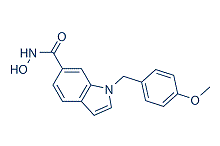
|
| DC8661 | Pimelic Diphenylamide 106(TC-H 106) Featured |
Pimelic diphenylamide 106 is a slow, tight-binding inhibitor of class I HDAC (HDAC 1, 2, and 3, with IC50 values of 150 nM , 760nM, and 370 nM, respectively), demonstrating no activity against class II HDACs.
More description
|

|
| DC71179 | GEM144 |
GEM144 is a potent and orally active DNA polymerase α (POLA1) and HDAC 11 dual inhibitor. GEM144 induces acetylation of p53, activation of p21, G1/S cell cycle arrest, and apoptosis. GEM144 has significant antitumor activity in human orthotopic malignant pleural mesothelioma xenografts.
More description
|

|
| DC71069 | JPS036 |
JPS036 is a benzamide-based Von Hippel-Lindau (VHL) E3-ligase proteolysis targeting chimeras (PROTAC). JPS036 degrades class I histone deacetylase (HDAC). JPS036 is potent HDAC1/2 degrader correlated with greater total differentially expressed genes and enhanced apoptosis in HCT116 cells.
More description
|

|
| DC71068 | JPS035 |
JPS035 is a benzamide-based Von Hippel-Lindau (VHL) E3-ligase proteolysis targeting chimeras (PROTAC). JPS035 degrades class I histone deacetylase (HDAC). JPS035 is potent HDAC1/2 degrader correlated with greater total differentially expressed genes and enhanced apoptosis in HCT116 cells.
More description
|

|
| DC71067 | JPS016 |
JPS016 is a benzamide-based Von Hippel-Lindau (VHL) E3-ligase proteolysis targeting chimeras (PROTAC). JPS016 degrades class I histone deacetylase (HDAC). JPS016 is potent HDAC1/2 degrader correlated with greater total differentially expressed genes and enhanced apoptosis in HCT116 cells.
More description
|

|
| DC71066 | JPS014 |
JPS014 is a benzamide-based Von Hippel-Lindau (VHL) E3-ligase proteolysis targeting chimeras (PROTAC). JPS014 degrades class I histone deacetylase (HDAC). JPS014 is potent HDAC1/2 degrader correlated with greater total differentially expressed genes and enhanced apoptosis in HCT116 cells.
More description
|

|
| DC70995 | 2-Hexyl-4-pentynoic acid |
2-Hexyl-4-pentynoic acid ((±)-2-Hexyl-4-pentynoic acid), valproic acid (VPA) derivative, exhibits potential roles of HDAC inhibition (IC50=13 µM) and HSP70 induction. Potent neuroprotective effects. 2-Hexyl-4-pentynoic acid causes histone hyperacetylation and protect against glutamate-induced excitotoxicity in cultured neurons.
More description
|

|
| DC70945 | [18F]-NT160 |
[18F]-NT160, a Florbetapir (18F)-radiolabeled NT160, is a diagnostic tool for positron emission tomography (PET). NT160 is a brain-penetrant and selective class-IIa HDAC inhibitor with an IC50 of 46 nM. NT160 exhibits a remarkably high inhibition against HDAC4, HDAC5, HDAC7, and HDAC9 with IC50s of 0.08 nM, 1.2 nM, 1.0 nM, and 0.9 nM, respectively.
More description
|

|
| DC8654 | PTACH (NCH-51) Featured |
PTACH (NCH-51) is a SAHA-based novel inhibitor of human HDAC. PTACH exerts potent growth inhibition against various human cancer cells, with EC50 values ranging from 1 to 10 μM.
More description
|
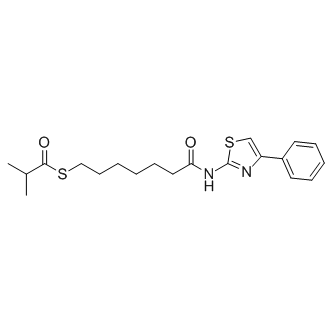
|
| DC7795 | RG2833 (RGFP109) Featured |
RG2833 is a brain-penetrant inhibitor of HDAC with IC50 values of 60 nM and 50 nM for HDAC1 and HDAC3, respectively.
More description
|
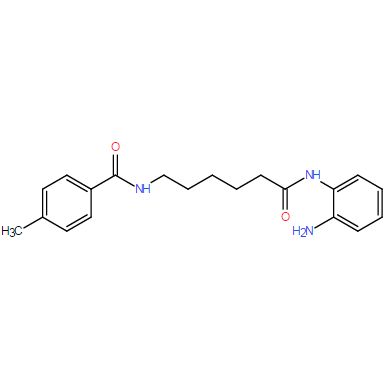
|
| DC12487 | TH-34 Featured |
TH34 is a potent HDAC6/8/10 inhibitor, induceing DNA damage-mediated cell death in human high-grade neuroblastoma cell lines.
More description
|
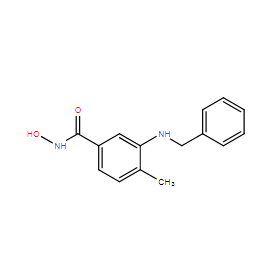
|
| DC10478 | Tinostamustine(EDO-S101) Featured |
Tinostamustine is the first representative of the A-DAC principle, a new approach in chemotherapy that uses fusion technology to combine an alkylating agent with a pan-histone deacetylase inhibitor (HDAC) to simultaneously damage DNA and block damage repa
More description
|
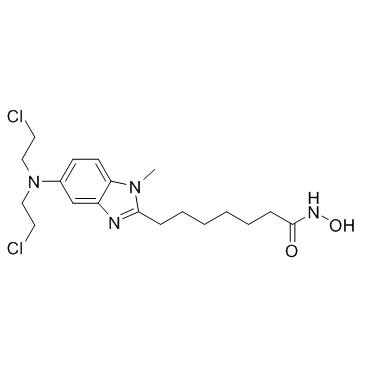
|
| DC6303 | Tubastatin A HCl Featured |
Tubastatin A is a potent and selective HDAC6 inhibitor with IC50 of 15 nM. It is selective against all the other isozymes (1000-fold) except HDAC8 (57-fold).
More description
|
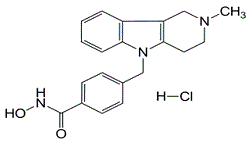
|
| DC70860 | UBD253 |
UBD253 (SGC-UBD253) is a potent, selective ubiquitin chemical probe for ubiquitin binding domain of HDAC6 with Kd of 84 nM (SPR), inhibits the HDAC6-ISG15 interaction (EC50=1.9 uM, nanoBRET).UBD253 (SGC-UBD253) displays little to no affinity for other USPs (>100-fold selectivity). SGC-UBD253 potently (<100 nM) binds HDAC6-UBD (ubiquitin binding domain), decreases the interaction between full-length HDAC6 with ISG15.
More description
|

|
| DC70815 | SW-101 |
SW-101 (SW101) is a potent, selective HDAC6 inhibitor with IC50 of 0.7 nM, >200-fold selectivity over HDAC1/2/3.SW-101 possesses excellent HDAC6 potency and selectivity, together with markedly improved metabolic stability and druglike properties compared to SW-100.SW-101 treatment elevates the impaired level of acetylated α-tubulin in the distal sciatic nerve, counteracts progressive motor dysfunction, and ameliorates neuropathic symptoms in a CMT2A mouse model bearing mutant MFN2.
More description
|

|
| DC70719 | PTG-0861 |
PTG-0861 (JG-265) is a novel potent, selective HDAC6 inhibitor with IC50 of 5.92 nM, >36-fold selectivity over other HDACs.PTG-0861 (JG-265) displays HDAC6 cellular target engagement with EC50 of 0.59 uM (ELISA), has in vitro and cellular selectivity superior to HDAC6-selective inhibitor citarinostat (ACY-241).PTG-0861 (JG-265) demonstrates potency against several blood cancer cell lines (e.g. MV4-11, MM1S), whilst showing limited cytotoxicity against non-malignant cells and CD-1 mice.PTG-0861 (JG-265) exihibits promising in vitro pharmacokinetics achieved with good safety profile in cells and in vivo.
More description
|

|
| DC70663 | NR-160 |
NR-160 (NR160) is a novel potent, selective inhibitor of histone deacetylase 6 (HDAC6) with IC50 of 30 nM, shows SI (75-1847 )over all HDAC class I isoforms.NR-160 induced α-tubulin acetylation (ac-α-tubulin) in treated acute myeloid leukemic (AML) cell line HL60, but not histone H3 (ac-H3) (a marker for the inhibition of class I HDACs).NR-160 enhances the cytotoxicity induction of bortezomib, epirubicin and daunorubicin on a panel of seven leukemia cell lines
More description
|

|
| DC70656 | NN-390 |
NN-390 (NN390) is a potent, selective HDAC6 inhibitor with IC50 of 9.8 nM, >200-550-fold selectivity over other HDAC isoforms.NN-390 inhibits primary cells of treatment-refractory Group 3 MB cells (SU_MB002) with IC50 of 2.33 uM.NN-390 is the first HDAC6-selective inhibitor to show therapeutic potential in metastatic Group 3 medulloblastoma (MB), an aggressive pediatric brain tumor often associated with leptomeningeal metastases and therapy resistance.NN-390 selectively targets cell population with a 44.3-fold therapeutic margin between patient-derived Group 3 MB cells in comparison to healthy neural stem cells.NN-390 demonstrated a 45-fold increased potency over HDAC6-selective clinical candidate citarinostat.
More description
|

|
| DC70600 | MJM-1 |
MJM-1 is a small-molecule brain-penetrant HDAC inhibitor that increases the overall level of histone 3 (H3) acetylation in prostate cancer cell line.MJM-1 injected intraperitoneally (i.p.) crossed the BBB in mice and could be detected in the hippocampus, a brain region that mediates memory.MJM-1 (post-training i.p. administration) enhanced hippocampus-dependent spatial memory consolidation in male mice.
More description
|

|
| DC70572 | LSH-A54 |
LSH-A54 is a potent, class I selective HDAC inhibitor with IC50 of 26.2 nM (HDAC1) and 59.3 nM (HDAC2);
LSH-A54 displays no significant inhibition against HADC3/6 (IC50>10 uM).
LSH-A54 exhibits antiproliferative properties against breast cancer cell lines T-47D (IC50=1.58 uM), MCF-7 (IC50=1.32 uM) and BT-474 (IC50=2.55 uM).
LSH-A54 attenuates cell migration significantly in wound healing assay and comparably to the pan-HDACi vorinostat, whereas the HDAC1-3 selective HDACi entinostat has no significant effect on cell migration.
LSH-A54 reduced the number of colonies significantly in clonogenic survival assay compared to entinostat and showed comparable activity to pan-HDACi vorinostat.
More description
|

|
| DC70516 | IRBM6 |
IRBM6 (Class I HDAC-IN-6) is a potent, class I selective HDAC inhibitor with EC50 of 50 nM (HeLa cellular), HDAC1/2/3 IC50 of 1.7/2.8/1.1 nM.IRBM6 weakly inhibits HDAC6 (IC50=177 nM) and is inactive at 5 uM against HDACs 4-7.IRBM6 showed a potent inhibitory effect on the growth TC-797s and two additional NUT carcinoma (NC) cell lines, PER-403, and 10-15.IRBM6 induces a transcriptional program of differentiation in NC cells, demonstrated large-scale changes in gene expression that were significantly enriched with differentiation gene sets and depleted of pro-growth gene sets, including those of MYC and E2F targets.IRBM6 repressed growth and induced differentiation of NUT carcinoma (NC) cells in proportion to inhibition of NUT transcriptional activity.
More description
|

|
| DC70419 | FT108 |
FT108 (FT-108) is a potent, selective HDAC6 inhibitor (IC50=26 nM) relative to other HDAC family members (HDAC3 IC50=6.68 uM and HDAC8 IC50=4.07 uM).
More description
|

|
| DC49590 | MC4343 |
MC4343 is a potent and dual inhibitor of EZH2 and histone deacetylase. MC4343 has the potential for the research of cancer disease.
More description
|

|
| DC49589 | KD 5170 |
KD 5170 is a pan inhibitor of histone deacetylases (HDACs) and exhibits broad spectrum antitumor activity in vitro and in vivo.
More description
|

|
| DC49588 | HDAC-IN-30 |
HDAC-IN-30 is a novel multi-target HDAC inhibitor, including HDAC1 (IC50=13.4 nM),HDAC2 (IC50=28.0 nM), HDAC3 (IC50=9.18 nM), HDAC6 (IC50=42.7 nM), HDAC8 (IC50=131 nM). HDAC-IN-30 exhibits potent antitumor efficacy.
More description
|

|
| DC49586 | PHD2/HDACs-IN-1 |
PHD2/HDACs-IN-1 is a potent PHD2/HDACs hybrid inhibitor (IC50s of 1.15 μM, 19.75 μM, 26.60 μM and 15.98 μM for PHD2, HDAC1, HDAC2 and HDAC6, respectively). PHD2/HDACs-IN-1 is a low-toxicity renoprotective agent for research of cisplatin-induced acute kidney injury (AKI).
More description
|

|